Photographing birds in flight has always been a challenge for me. Slow-moving targets are not too difficult to keep in sight, but framing them in the viewfinder is only the first step in the process. They must also be kept in focus and the exposure must compensate for the brightness of the subject and the intensity of light in the background.
The pink sky is bright, causing the camera to "squint," so the exposure must be manually increased to keep the Great Egret from being darkly shadowed:
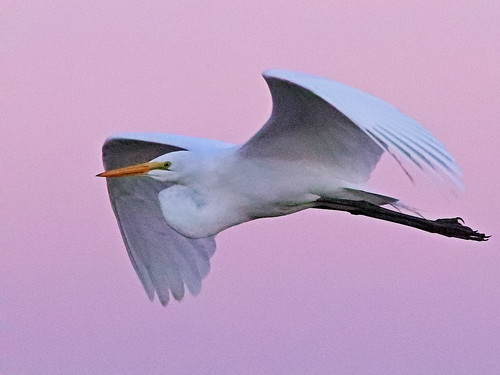
The blue water is darker, and the camera tries to compensate by increasing the exposure. This tendency must be reigned in to keep from over-exposing the white bird:

With small birds perched in the foliage, the camera tends to take care of all this automatically. I usually just set the aperture as wide as possible, to isolate the subject from distracting objects in the background. Birds in groups or in flight are not as accommodating, so the aperture must be narrowed to allow a greater depth of sharp focus, as was necessary with these White Ibises:

A dark and a white bird against the morning sky-- a Little Blue Heron had a close encounter with a Great Egret:

Black birds in flight are particularly troublesome, as their plumage provides little contrast to show off their feather patterns. Reflected sunshine and pure luck allowed me this shot of a Double-crested Cormorant:
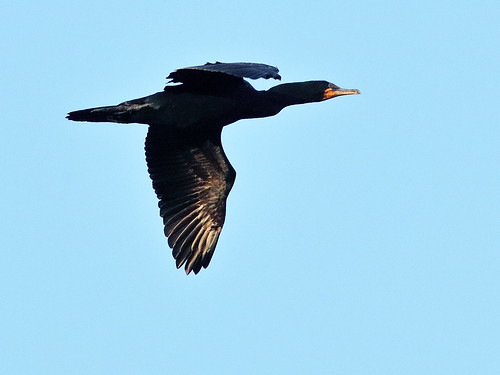
A Red-winged Blackbird puffed up his feathers to catch the light:
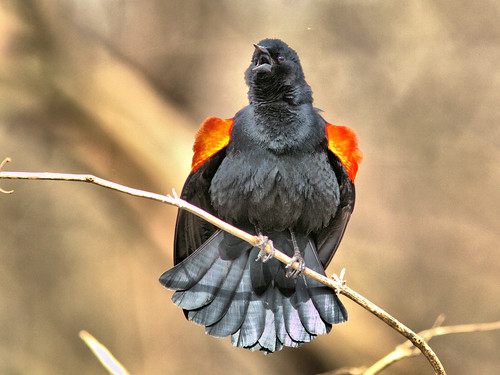
Direct sunlight reveals the iridescence of a Common Grackle...
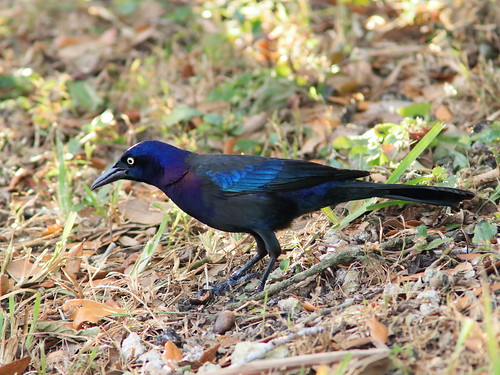
...and a Boat-tailed Grackle:
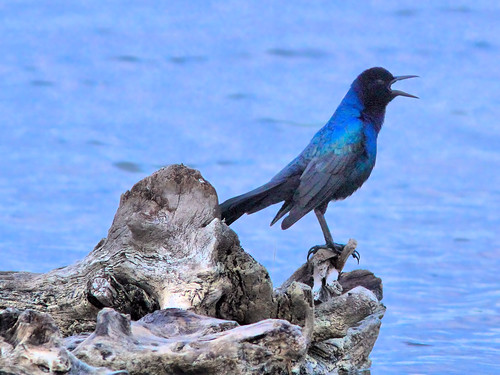
White birds sometimes show up best when they are illuminated from the side or even slightly from behind:
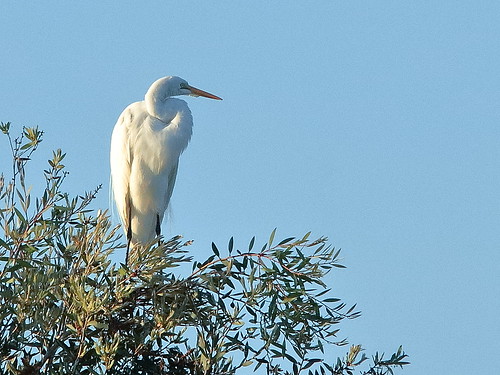
The sky has presented some interesting sights this month. Since we walk out into the wetlands in pre-dawn darkness, we are aware of the movements of celestial objects-- the Moon, planets and bright stars.
Lately we have watched Venus move towards the eastern horizon. On the morning of January 2, the waning crescent Moon was aligned with Venus and Jupiter.
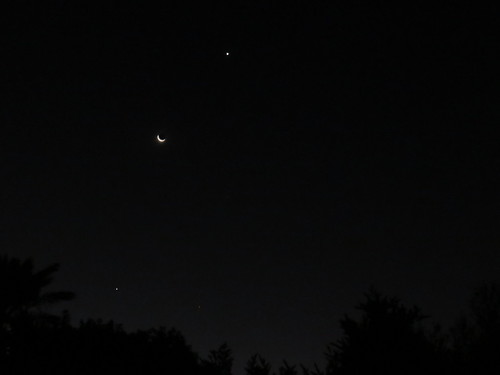
Both planets brightened up as they moved away behind the sun, appearing to move closer together. Actually, the distance between them is never less than 365 million miles. Venus is much closer to the sun and moves along its 422.5 million mile orbit at 78,337 mph (35.02 km/second). Jupiter moves more slowly, at 29,236 mph (13.07 km/second), along its huge 3 billion mile orbit and takes 4331 days to circle the sun.
On January 17, they shone brightly before sunrise:

This week we witnessed a "double feature," first a full eclipse of the Moon on January 20. The Wolf Moon rose over our back yard:
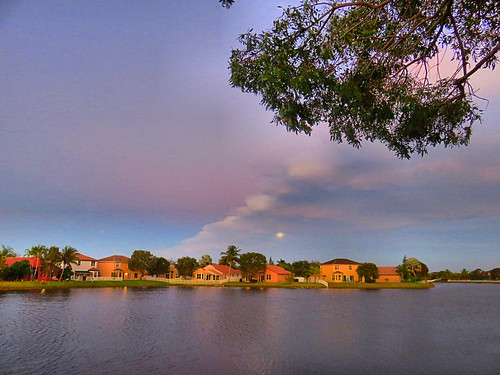 My hand-held images are not very crisp:
My hand-held images are not very crisp:

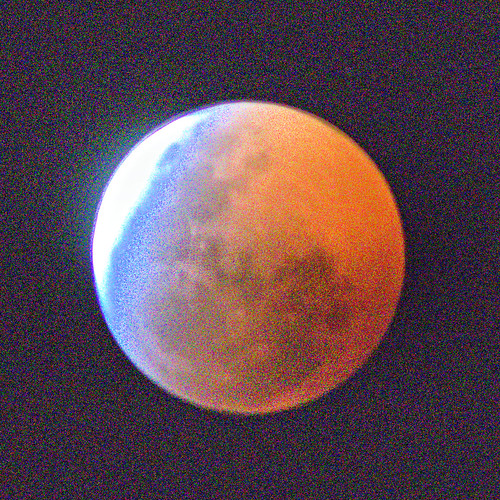

Then, stormy skies caused us to miss the conjunction of Venus and Jupiter, when they would be horizontally aligned. Their conjunction on January 22 would bring them almost 2 degrees apart, about the width of 5 full Moons. Here they were on January 21:

The morning after the conjunction (January 23) was also overcast, and they briefly peeked out from behind the clouds. Now Venus had moved beneath Jupiter:

= = = = = = = = = = = = = = =
Linking to Misty's CAMERA CRITTERS,
Linking to Eileen's SATURDAY'S CRITTERS,
Linking to SKYWATCH FRIDAY by Yogi, Sylvia and Sandy
Linking to WEEKEND REFLECTIONS by James
Linking to BirdD'Pot by Anni
Linking to Our World Tuesday by Lady Fi
Linking to Wild Bird Wednesday by Stewart
Linking to Wordless Wednesday (on Tuesday) by NC Sue
Linking to ALL SEASONS by Jesh
________________________________________________
Please visit the links to all these memes to see some excellent photos on display
________________________________________________
A cold front delivered windy cold weather to south Florida. It got down to 58 degrees F (14.4 degrees Celsius) one morning. Although there was no danger of frostbite, I had to wear a jacket!
A trifecta of long-legged waders greeted us on November 19-- a Great Egret with Tricolored and Little Blue Herons adorned the top of a tree:

Earlier that morning, just at sunrise, I had encountered a large male Bobcat along the gravel path:

Bunting and Bobcat on the same morning walk-- what could be better? The plumage of a female Painted Bunting blended so well with the foliage that I had trouble seeing her in the viewfinder:

After the front passed on November 18 there were fair skies and still water before sunrise:

This is the view from the lakeside marsh as the sun touched the pine bank on the opposite shore:

The clouds were mirrored on the surface of the lake:

I briefly caught sight of a migrating immature Rose-breasted Grosbeak:

Male Boat-tailed Grackles congregated in a treetop:

In the rookery, the Yellow-crowned Night-Herons were developing golden crowns in preparation for the breeding season. Unfortunately, many trees which were blown into the canal by Hurricane Irma need to be cut and removed this week. I hope that some trees are spared for the herons:

A Great Egret perched in perfect morning side-light:

An acrobatic female Black-throated Blue Warbler plucked tiny insects from Ligustrum flowers:

At the local Bald Eagle nest, the pair had been gathering sticks and then took a break, roosting together on a nearby Australian Pine. The larger female (Jewel) is on the left. Her mate (Pride) looked her way...

...and began calling and spreading his wings:


Jewel's calls turned the performance into a duet:

Successful copulation followed:




= = = = = = = = = = = = = = =
Linking to Misty's CAMERA CRITTERS,
Linking to Eileen's SATURDAY'S CRITTERS,
Linking to SKYWATCH FRIDAY by Yogi, Sylvia and Sandy
Linking to WEEKEND REFLECTIONS by James
Linking to BirdD'Pot by Anni
Linking to Our World Tuesday by Lady Fi
Linking to Wild Bird Wednesday by Stewart
Linking to Wordless Wednesday (on Tuesday) by NC Sue
Linking to ALL SEASONS by Jesh
________________________________________________
Please visit the links to all these memes to see some excellent photos on display
________________________________________________
The month of March gave south Florida its coldest temperatures of the year, dipping into the high thirties (~3 degrees Celcius) with one of our several cold (or should I say "cool?") fronts. Rain threatened with their approach but precipitation was sparse...
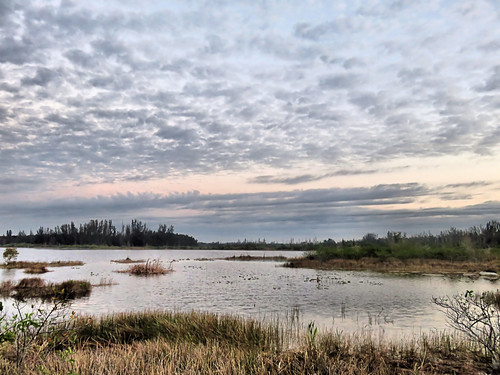
...and clear skies followed for several days after the passage of each front:
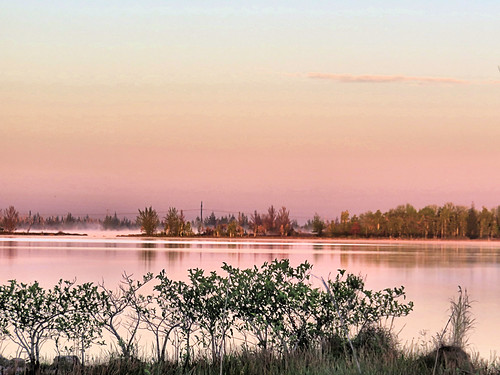
As a teenager working towards a Boy Scout merit badge I started keeping daily logs of bird sightings. I still have my old records, and I enjoy re-living some of the sightings.
The habit of carrying a pencil and a pocket-sized spiral notebook did not persist for very long, and even the notes I made about first or unusual bird sightings became more and more sketchy, finally deteriorating to date, name of bird and place-- the latter sometimes ambiguous.
I assumed I would always remember the exact location of "Charlie's Woods," "up at Camp" and "down the river," but now they do not exist. These are the entries for my first ten weeks of birding (Don't the rubber-stamped dates lend an air of authenticity?):

Stopping to take notes interfered with the joy of birding, and diverted my attention away from the sky and surroundings, possibly depriving me of exciting sightings.
Fast forward to the electronic revolution and the age of eBird. After moving to Florida I readily adapted to using this Cornell University Laboratory of Ornithology iPhone application to report my sightings. Yet there remained a certain nuisance factor, as I still had to stop and occupy both hands to punch in and update sightings.
After all, with snakes and fire ants to contend with, I was already looking down half the time just to walk from place to place. Then I found out that I could use the iPhone speech recognition feature. The eBird filter should be set to species expected locally. This will limit the matches to a single species or a select few.
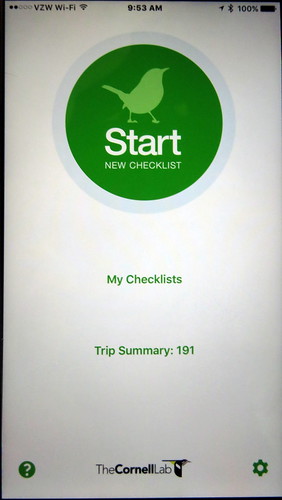
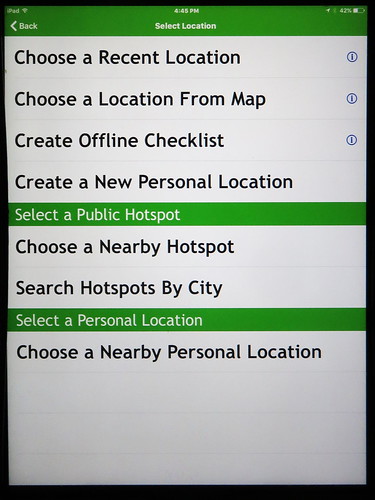
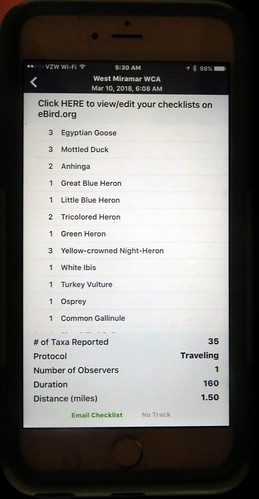
Talking to the eBird app requires one to adopt a spartan language style. Use as few syllables as necessary. Speak distinctly, sounding every consonant. If you don't, your "Osprey" becomes "odd spray." Better to say "OHspray."
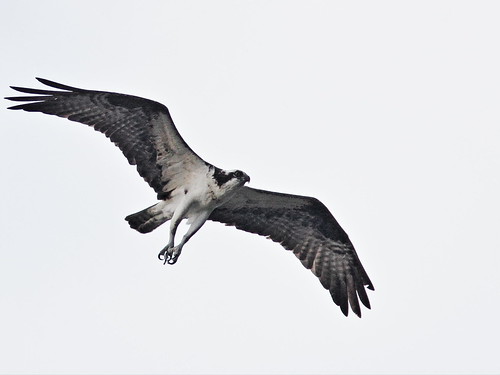
Say "Mottled Duck" too fast and it comes out "Matilda," or fail to pronounce the "TT" results in "modeled," neither of which matches a species in the eBird database. Ths Mottled Duck is in the company of a Black-necked Stilt (for which "black, hyphen, neck" will suffice for eBird):

A White Ibis must be called a "hWyte ibis" lest it become "what I best."
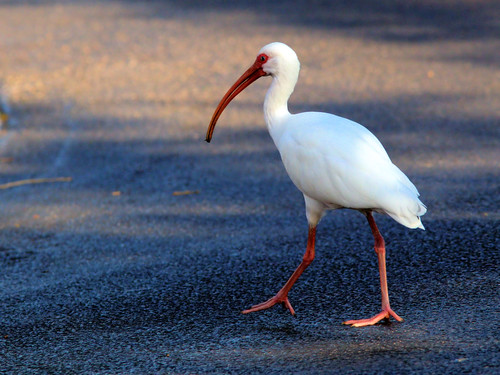
Never use plurals, as they will be translated to possessives such as dove's and sparrow's. Goose matches many species while geese does not. Keep it short and simple. "Egyptian" is all you need to say to call up the Egyptian Goose:

"European" is enough to auto-complete the Starling...

...and "Loggerhead" matches the only bird in our local list. The local filter produces the Shrike but ignores the rare Loggerhead Kingbird (and Turtle):
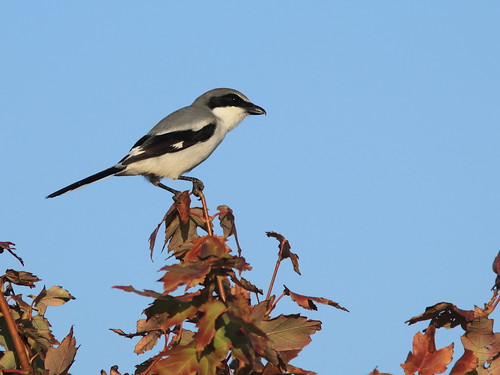
There is no such bird as a bluejay, so say "Blue, Jay:"

Make sure the syllables are run together where appropriate, so that your "kingfisher" does not summon an unrecognized "King Fisher." Only the Belted Kingfisher is selected in south Florida, while you may need to choose from a list of kingfishers in south Texas or Latin America:

Say "hyphen" when there is one in a bird's name -- it's a "red, hyphen, bell" if you want to report a Red-bellied Woodpecker in Florida (the filter in the western US would turn up a sapsucker!):

Truncating the names actually improves accuracy. For example, "boat, hyphen, tail" is enough for Boat-tailed Grackle:

"Tricolored" will match the Heron by that first name, if you do not improperly add a hyphen:

Don't worry if "Mourning Dove" comes out "Morning Dove," as eBird will automatically spell-check it and enter it properly:
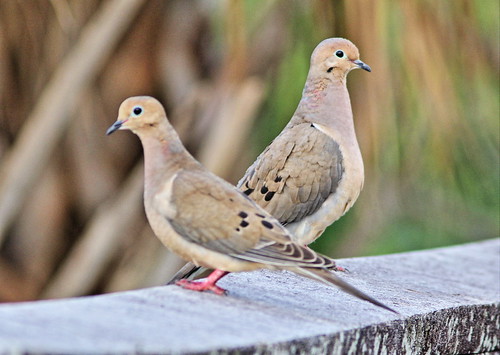
The eBird app's artificial intelligence (AI) also automatically drops the "e" in "Downey" Woodpecker:

However, eBird seems to ignore a British flair, and refuses to match your Gray Catbird, which Apple's AI insists on spelling as "grey," so simply say "catbird," (but not "cat, bird") to enter it correctly:
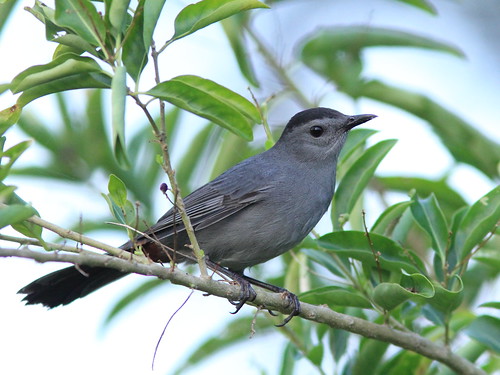
Similarly, to keep the Blue-gray Gnatcatcher from defaulting to unacceptable "grey," simply say "blue, hyphen, letter G."

The correct species will pop up if you leave off "Heron" and just say "Great, Blue"...
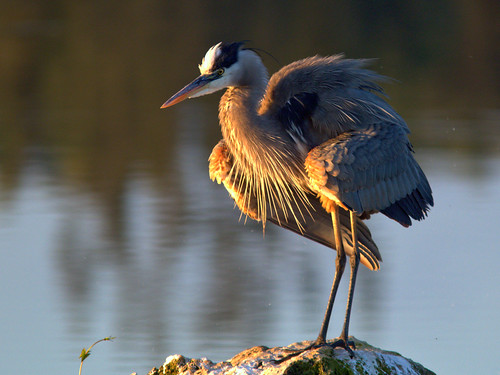
...or "Little, Blue:"

"Red hyphen shoulder" is enough for the Red-shouldered Hawk:

I could go on and on, but if you haven't used speech recognition with the eBird app, try it and you may like it! This feature also simplifies addition of species comments and other observations about weather and habitat.
Oh, and some bird names, notably "vireo" for me, will never be properly recognized, although "white hyphen letter E" will match with the White-eyed Vireo...

...and "red hyphen letter R" brings up the Red-eyed Vireo:

If all else fails, go back to punching in the full name or its four-letter banding code, but watch where you step!
= = = = = = = = = = = = = = =
Linking to Misty's CAMERA CRITTERS,
Linking to Eileen's SATURDAY'S CRITTERS,
Linking to SKYWATCH FRIDAY by Yogi, Sylvia and Sandy
Linking to WEEKEND REFLECTIONS by James
Linking to BirdD'Pot by Anni
Linking to Our World Tuesday by Lady Fi
Linking to Wild Bird Wednesday by Stewart
Linking to Wordless Wednesday (on Tuesday) by NC Sue
Linking to ALL SEASONS by Jesh
________________________________________________
Please visit the links to all these memes to see some excellent photos on display
________________________________________________





























































